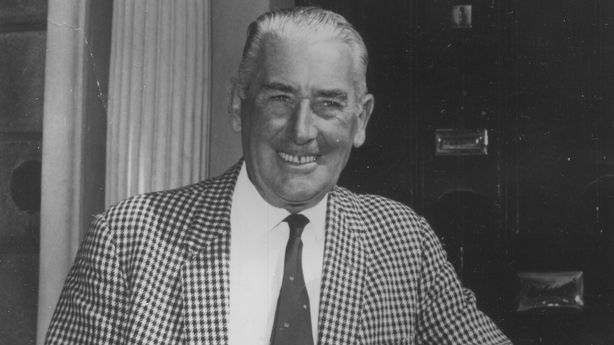We're delighted to present an extract from A Leaf in the Wind, the posthumous memoir from Matt Cullen, edited by his son Michael and newly published by Gregmar Books.
A Leaf in the Wind is Matt Cullen's memoir, an Irishman’s personal story from the last century. Matt’s life veered from a buffeting in the turbulence of personal despair and grief to happiness and triumph. It is a tale of hardship, courage, resilience, achievement and love, where Matt recalls his escape from a boys’ orphanage to his vivid memories of Ireland’s Revolution and the tragic Civil War. He writes of his time spent in New York during the Roaring Twenties and his return to Ireland to pursue his interest in sport, politics and business. He also recounts how he found lasting love and joy in marriage, family and friends.
An old rabbi with a long white beard and a Borsalino hat remains a fond memory from my days living in Portobello, the Dublin south city area named after a British victory over the Spanish at the Battle of Portobello in Panama in 1739. Cherished by the youngsters in our neighbourhood, the rabbi always wore a long black coat sown with deep pockets. Whenever he saw us out playing on the street, he would wave and summon us over to him. He would reach into his coat and hold out monkey nuts on the flats of his hands. With his eyes tightly shut, he stood and waited motionless until all the nuts were taken. He would then mutter something in what was presumably Yiddish, before shuffling off down the street.
None of us had the remotest idea what the rabbi said but it didn’t matter as he always managed to brighten up our day. He ignored the older kids in the neighbourhood, which is probably why they gave him and his long black coat the rather irreverent nickname: Sacks.
Our family lived on Walworth Road, not far from the Jewish synagogue on Stamer Street. My parents were married in St Mary’s Church on Haddington Road in 1903. New buildings in and around Clanbrassil Street and South Circular Road had become affordable homes for Jewish immigrants who had fled the pogroms in Russia in the 1890s. Dublin’s Jewish community climbed to 5,500 within a generation, many them living in Little Jerusalem.
Our Jewish neighbours were kind and friendly people, much given to the playing of classical music in their homes, the piano and violin being their most favoured instruments; but not for them a Steinway or Stradivarius. Before Passover, some of the poorer Jewish families that lived near us would ask my parents to store their cooking utensils, in keeping with their religious practice. Our family would look after everything from mixing bowls to cutting boards until after Passover. Strictly speaking, the items should have been disposed of entirely, an Orthodox practice our neighbours could ill afford.
In those days, touring traditional German brass bands would visit Dublin. Sometimes they would come to our neighbourhood, striking up marching tunes from street to street. Every Sunday morning, a ceremonial army parade made its way to the local Protestant church. Participating British soldiers, drawn from the many garrisons in and around Greater Dublin, looked resplendent in their military regalia and tall busby headgear as they trooped along Portobello’s streets with a swagger that could be construed as conceited.

My parents wanted to enroll me as a pupil in Synge Street Christian Brothers. However, I was too young, so I joined my older sister, Nancy, at a kindergarden in Grantham Street. Brief as my three years spent in Little Jerusalem were, the time was of immense value to me as a young, impressionable boy and instilled in me a deep curiosity about the Jewish people. Little Jerusalem produced several famous and respected names, including Ireland’s first Chief Rabbi, Issac Herzog. The community was also home to the Briscoe family.
Bob Briscoe was a Fianna Fáil TD from 1927 to 1965 and over the years we met up on several occasions. He became Dublin’s first Jewish Lord Mayor in 1956. Briscoe was active in the IRA and accompanied Éamon de Valera to the US during the War of Independence. He insisted that being "a Hebrew" in no way lessened his Irishness. He was sent to Germany by Michael Collins in 1919 to procure arms for the IRA. One of Briscoe’s daughters, Miriam, converted to Catholicism and became a Carmelite nun.
Another name associated with Little Jerusalem was James Joyce’s fictional ad salesman character in Ulysses, Leopold Bloom. Bloom was 'born’ at 52 Clanbrassil Street in 1866. Joyce’s day-in-the-life novel from June 16, 1904, was hailed by some as a masterpiece, above reproach, while others decreed that anyone who can actually complete the 720 pages with a modicum of understanding was an oddity. As Stephen Dedalus remarked in Ulysses, it would have been a feat in 1904 to cross Dublin in Edwardian fashion and a straw boater hat without passing a pub. It may have been an even greater achievement for anyone to traverse the city while stopping off in every pub along the way. Dublin pubs were the order of the day, topping the city’s social life, but unerringly the excuse for many an altercation.
Gallery owner and jazz aficionado Gerald Davis has been a prominent member of Dublin’s Jewish community since the Sixties. As a Jew, Davis said there was something special about being Irish. "To be both, at the same time, is rare," he added. Davis, who famously dresses up as Leopold Bloom every Bloomsday in June, pointed out that, strictly speaking, ‘Poldy’ was not a Jew, as his mother, Ellen Higgins, was born a Catholic. "Neither, in the eyes of his fellow citizens, was he a proper Irishman," Davis added. "For Irish Jews, there’s this marvellous ambivalence."

A Leaf in the Wind by Matt Cullen (published by Gregmar Books) is out now - find out more here.

